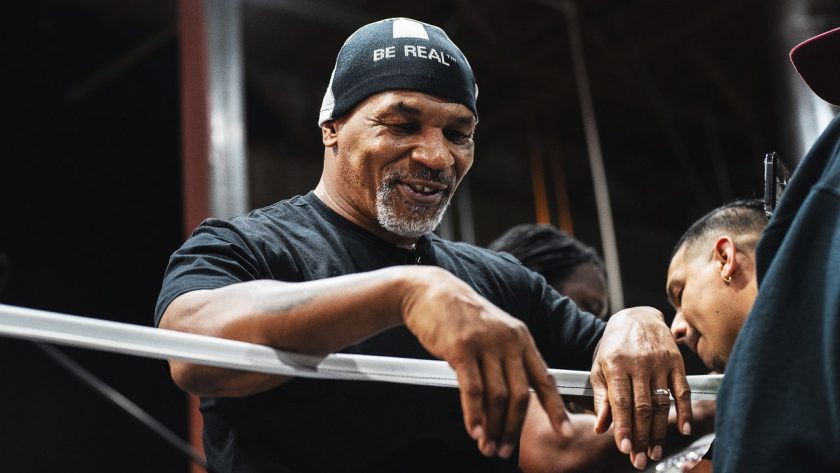Mike Tyson leans back against the ropes. The 59-year-old many consider the last of the legendary heavyweight champs stands in a boxing ring, wearing white New Balance sneakers, a black t-shirt, black short shorts, and a black-and-white skullcap that reads “Be Real.” He studies former UFC heavyweight champ Francis Ngannou, who throws a jab-cross combo again and again into the right hand and the gut of a heavily padded Dewey Cooper, Ngannou’s long-time trainer. “Throw it straight,” Tyson says, softly but forcefully. Iron Mike is a head shorter than the 6’4” mixed martial artist they call Predator, but when he steps forward and hits Cooper with his own cross, the pop echos through the cavernous room. Dozens of reporters have come to a loading dock, 15 minutes from the Las Vegas Strip, which has been converted into a boxing gym. One shouts Tyson a question about Ngannou’s progress. “He’s better now than he was last week,” Tyson answers. Ngannou throws the combo again, his right hand crashing towards Cooper’s liver. Tyson nods. “Yeah, that’s the one.”
In January, Ngannou exited the UFC amidst a contract dispute, becoming the first reigning champ to leave the organization in almost 20 years. Later this month, the 37-year-old will enter the ring for his debut boxing match: a 10-round bout against WBC Heavyweight Champion Tyson Fury in Riyadh, Saudi Arabia. A crossover promotion like this one—or its 2017 predecessor between Floyd Mayweather and Conor McGregor—was always sure to draw attention. Certainly, a slice of fight fans love a tactical battle, but the public desires spectacle most of all. The combat sports world’s story this last decade has centered on boxing’s fall and the UFC’s rise, but Ngannou says he’ll earn more in one event—$10 million, at least according to a Fury quote at a prefight presser—than he did in years in the octagon. And the Cameroonian fighter with a superhero build arrived with an ace up his sleeve. “I’ve been in touch with Mike Tyson the past four years since the first time that I met him on his podcast,” Ngannou tells me. “I asked him: when I fight Tyson Fury, would he be in my corner? And he said yes.”
Tyson the Trainer is an irresistible image. The great ones rarely coach (part of the reason Deion Sanders has become a sensation in Colorado), and Tyson, specifically, seems an unlikely guide. “That was always a riddle to me: why are these guys that are great not great coaches?” says Cooper, who’s been friends with Tyson since the mid-90s and helped get his pal onboard. He thinks there’s a simple reason that you don’t see GOATs grab clipboards: “I’m just giving you the honest fact: it boils down to being lazy and selfish and not wanting to release all that information they have inside. That’s what it boils down to. Don’t die with that! Let them secrets go.”
But Gary Smith, the former Sports Illustrated writer who penned the most famous Tyson profile back in 1988, thinks it’s deeper than that. “Those kind of guys have this burning compulsion to dominate. To conquer. It’s just a different proposition altogether to show up each day and spend seven hours teaching the minutiae of a craft,” Smith says. “For Tyson, it was like a life-and-death scenario every time he stepped into the ring. How do you package that and put it into somebody else?”
For Smith, the secret to Tyson’s success was his ability to bring all his childhood fear and pain into the ring with him. “Everything from his past was present tense,” Smith says. “He was bringing with him all these nights in the middle of Brownsville where you either can get killed or have to kill at a moment’s notice. And that’s what he was reliving, essentially, when he stepped between the ropes. He’d turn that fear into a rage and project it onto somebody else.”



